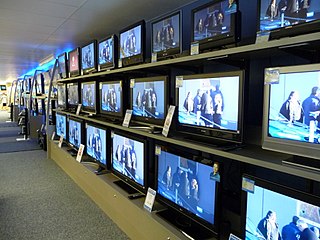
Television (TV) is a telecommunication medium for transmitting moving images and sound. The term can refer to a television set, or the medium of television transmission. Television is a mass medium for advertising, entertainment, news, and sports.

Interlaced video is a technique for doubling the perceived frame rate of a video display without consuming extra bandwidth. The interlaced signal contains two fields of a video frame captured consecutively. This enhances motion perception to the viewer, and reduces flicker by taking advantage of the phi phenomenon.

Telecine is the process of transferring film into video and is performed in a color suite. The term is also used to refer to the equipment used in this post-production process.
A line doubler is a device or algorithm used to deinterlace video signals prior to display on a progressive scan display.
Enhanced-definition television, or extended-definition television (EDTV) is a Consumer Electronics Association (CEA) marketing shorthand term for certain digital television (DTV) formats and devices. Specifically, this term defines an extension of the standard-definition television (SDTV) format that enables a clearer picture during high-motion scenes compared to previous iterations of SDTV, but not producing images as detailed as high-definition television (HDTV).
In video technology, 24p refers to a video format that operates at 24 frames per second frame rate with progressive scanning. Originally, 24p was used in the non-linear editing of film-originated material. Today, 24p formats are being increasingly used for aesthetic reasons in image acquisition, delivering film-like motion characteristics. Some vendors advertise 24p products as a cheaper alternative to film acquisition.

The display resolution or display modes of a digital television, computer monitor or display device is the number of distinct pixels in each dimension that can be displayed. It can be an ambiguous term especially as the displayed resolution is controlled by different factors in cathode ray tube (CRT) displays, flat-panel displays and projection displays using fixed picture-element (pixel) arrays.
Deinterlacing is the process of converting interlaced video into a non-interlaced or progressive form. Interlaced video signals are commonly found in analog television, digital television (HDTV) when in the 1080i format, some DVD titles, and a smaller number of Blu-ray discs.

720p is a progressive HD signal format with 720 horizontal lines/1280 columns and an aspect ratio (AR) of 16:9, normally known as widescreen HD (1.78:1). All major HD broadcasting standards include a 720p format, which has a resolution of 1280×720p.
1080i is a combination of frame resolution and scan type. 1080i is used in high-definition television (HDTV) and high-definition video. The number "1080" refers to the number of horizontal lines on the screen. The "i" is an abbreviation for "interlaced"; this indicates that only the even lines of each frame, then only the odd lines, are drawn alternately, so that only half the number of lines are ever updated at once. A related display resolution is 1080p, which also has 1080 lines of resolution; the "p" refers to progressive scan, which indicates that each full frame appears on the screen in sequence.
High-definition video is video of higher resolution and quality than standard-definition. While there is no standardized meaning for high-definition, generally any video image with considerably more than 480 vertical scan lines or 576 vertical lines (Europe) is considered high-definition. 480 scan lines is generally the minimum even though the majority of systems greatly exceed that. Images of standard resolution captured at rates faster than normal, by a high-speed camera may be considered high-definition in some contexts. Some television series shot on high-definition video are made to look as if they have been shot on film, a technique which is often known as filmizing.

1080p is a set of HDTV high-definition video modes characterized by 1,920 pixels displayed across the screen horizontally and 1,080 pixels down the screen vertically; the p stands for progressive scan, i.e. non-interlaced. The term usually assumes a widescreen aspect ratio of 16:9, implying a resolution of 2.1 megapixels. It is often marketed as Full HD or FHD, to contrast 1080p with 720p resolution screens. Although 1080p is sometimes informally referred to as 2K, these terms reflect two distinct technical standards, with differences including resolution and aspect ratio.
In video, a field is one of the many still images displayed sequentially to create the impression of motion on the screen. Two fields comprise one video frame. When the fields are displayed on a video monitor they are "interlaced" so that the content of one field will be used on all of the odd-numbered lines on the screen, and the other field will be displayed on the even lines. Converting fields to a still frame image requires a process called deinterlacing, in which the missing lines are duplicated or interpolated to recreate the information that would have been contained in the discarded field. Since each field contains only half of the information of a full frame, however, deinterlaced images do not have the resolution of a full frame.
Low-definition television (LDTV) refers to TV systems that have a lower screen resolution than standard-definition television systems. The term is usually used in reference to digital television, in particular when broadcasting at the same resolution as low-definition analog television systems. Mobile DTV systems usually transmit in low definition, as do all slow-scan television systems.
1440p is a family of video display resolutions that have a vertical resolution of 1440 pixels. The p stands for progressive scan, i.e. non-interlaced. The 1440 pixel vertical resolution is double the vertical resolution of 720p, and one-third more than 1080p. QHD or WQHD is the designation for a commonly used display resolution of 2560 × 1440 pixels in a 16:9 aspect ratio. As a graphics display resolution between 1080p and 4K, Quad HD is regularly used in smartphone displays, and for computer and console gaming.
Display motion blur, also called HDTV blur and LCD motion blur, refers to several visual artifacts that are frequently found on modern consumer high-definition television sets and flat panel displays for computers.
Faroudja Labs was a San Francisco–based IP and research company founded by Yves Faroudja. Faroudja Labs shouldn't be confused with Faroudja Enterprises, Yves Faroudja's latest venture.
High-definition television (HDTV) describes a television or video system which provides a substantially higher image resolution than the previous generation of technologies. The term has been used since at least 1933; in more recent times, it refers to the generation following standard-definition television (SDTV). It is the current de facto standard video format used in most broadcasts: terrestrial broadcast television, cable television, satellite television.
Display lag is a phenomenon associated with most types of liquid crystal displays (LCDs) like smartphones and computers and nearly all types of high-definition televisions (HDTVs). It refers to latency, or lag between when the signal is sent to the display and when the display starts to show that signal. This lag time has been measured as high as 68 ms, or the equivalent of 3-4 frames on a 60 Hz display. Display lag is not to be confused with pixel response time, which is the amount of time it takes for a pixel to change from one brightness value to another. Currently the majority of manufacturers quote the pixel response time, but neglect to report display lag.

4K resolution refers to a horizontal display resolution of approximately 4,000 pixels. Digital television and digital cinematography commonly use several different 4K resolutions. In television and consumer media, 3840 × 2160 is the dominant 4K standard, whereas the movie projection industry uses 4096 × 2160.






